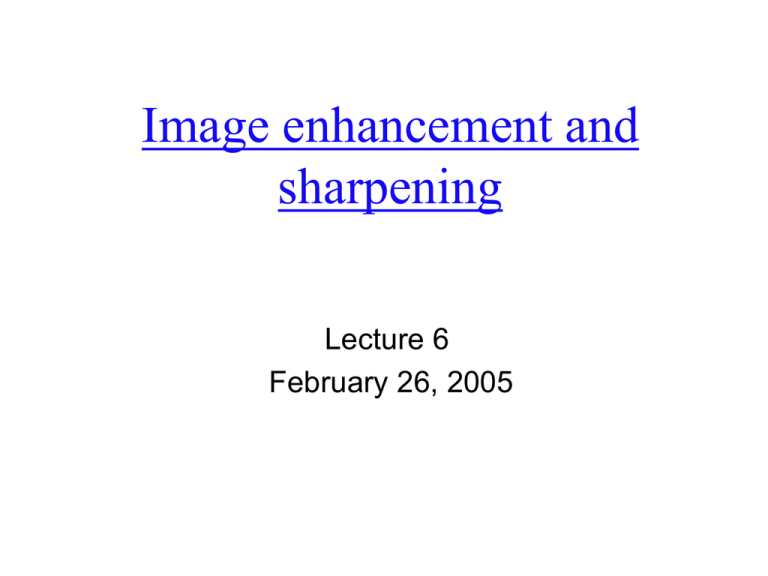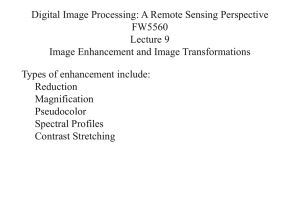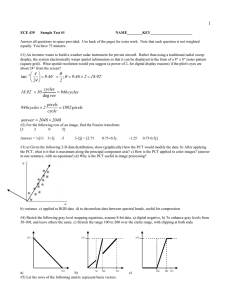Image enhancement and sharpening Lecture 6 February 26, 2005
advertisement

Image enhancement and sharpening Lecture 6 February 26, 2005 Procedures of image processing Preprocessing Radiometric correction is concerned with improving the accuracy of surface spectral reflectance, emittance, or back-scattered measurements obtained using a remote sensing system. Detector error correction, Atmospheric and topographic corrections Geometric correction is concerned with placing the above measurements or derivativeproducts in their proper locations. Information enhancement Point operations change the value of each individual pixel independent of all other pixels Local operations change the value of individual pixels in the context of the values of neighboring pixels. Information enhancement includes image reduction, image magnification, transect extraction, contrast adjustments (linear and non-linear), band ratioing, spatial filtering, fourier transformations, principle components analysis, texture transformations, and image sharpening (I will not talk about them in this lecture since it is already too much, I will see if I can talk them in a later time, otherwise, …) Information extraction Post-classification Information output Image or enhanced image itself, thematic map, vector map, spatail database, summary statistics and graphs 1. Image reduction 2x reduction 1. Sampling every other row or column or Nearest Neighbor in ENVI 2. Pixel aggregate (average of 4 pixels) 2. Image magnification 2x magnification 1. Duplicate every row and colume or Nearest Neighbor in ENVI 2. Bilinear resampling 3. Cubic resampling A common interface in ENVI For Spatial • Subsetting • Reduction • Magnification 3. Transects (spatial profiles) 4. Spectral profiles 5. Contrast Enhancement (stretch) Materials or objects reflect or emit similar amounts of radiant flux (so similar pixel value) Low-contrast imagery with pixel range less than the designed radiometric range 20-100 for TM less than the designed 0-255 To improve the contrast: Linear technique Non-linear technique Minimum-maximum contrast stretch Percentage linear contrast stretch Standard deviation contrast stretch Piecewise linear contrast stretch Histogram equalization Contrast enhancement is only intended to improve the visual quality of a displayed image by increasing the range (spreading or stretching) of data values to occupy the available image display range (usually 0-255). It does not change the pixel values, unless save it as a new image. It is not good practice to use saved image for classification and change detection. Minimum-maximum contrast stretch BVout BVin min k max k min k quant k where: - BVin is the original input brightness value - quantk is the range of the brightness values that can be displayed on the CRT (e.g., 255), - mink is the minimum value in the image, - maxk is the maximum value in the image, and - BVout is the output brightness value Percentage linear and standard deviation contrast stretch X percentage (say 5%) top or low values of the image will be set to 0 or 255, rest of values will be linearly stretched to 0 to 255 ENVI has a default of a 2% linear stretch applied to each image band, meaning the bottom and top 2% of image values are excluded by positioning the range bars at the appropriate points. Low 2% and top 2% will be saturated to 0 and 255, respectively. The values between the range bars are then stretched linearly between 0 and 255 resulting in a new image. If the percentage coincides with a standard deviation percentage, then it is called a standard deviation contrast stretch. For a normal distribution, 68%, 95.4%, 99.73% values lie in 1, 2 , 3 . So 16% linear contrast stretch is the 1 contrast stretch. original Saturating the water Stretching the land Special linear contrast stretch Or Stretch on demand Saturating the land Stretching the water Piecewise linear contrast stretch When the histogram of an image is not Gaussian (bimodal, trimodal, …), it is possible to apply a piecewise linear contrast stretch. But you better to know what each mode in the histogram represents in the real world. Stretch both land and water Nonlinear contrast stretch: histogram equalization It automatically reduces the contrast in the very light or dark parts of the image associated with the tails of a normally distributed histogram. Some pixels that originally have differently values are now assigned the same value (perhaps loss information), while other value that were once very close together are now spread out, increasing the contrast between them Scan the p272 and 274 Histogram equalized Original 6. Band Ratioing Sometimes differences in brightness values from identical surface materials are caused by topographic slope and aspect, shadows, atmospheric constitutional change, or seasons changes in sun angle and intensity. Band ratio can be applied to reduce the effects of such environmental conditions. In addition, band ratio also help to discriminate between soils and vegetation BVi , j ,ratio BVi , j ,k BVi , j ,l where: - BVi,j,k is the original input brightness value in band k - BVi,j,l is the original input brightness value in band l - BVi,j,ratio is the ratio output brightness value None of the single band relation passed the Durbin-Watson statistical test. Source: Vincent et al., 2004 Indicating the best spectral ratio model is more robust than the best model derived from single Bands, with regard to changes in sun angle (season), atmospheric transmission, and instrument Settings between Landsat 5 and 7 7. Spatial filtering to enhance low, high frequency detail, and edges Spatial frequency is the number of changes in brightness value per unit distance for any particular part of an image. If there are very few changes in brightness value over a given area in an image, this is referred to as a low-frequency area. Conversely, if the brightness values change dramatically over short distances, this is an area of high-frequency detail. To see the spatial frequency, we look at the local (neighboring) pixel value changes. The spatial frequency may be enhanced or subdued using: Spatial convolution filtering: based primarily on the use of convolution masks Fourier analysis: mathematically separates an image into its spatial frequency components 7.1 Spatial convolution filtering A linear spatial filter is a filter for which the brightness value (BVi,j,out) at location i,j in the output image is a function of some weighted average (linear combination) of brightness values located in a particular spatial pattern around the i,j location in the input image. The process of evaluating the weighted neighboring pixel values is called two-dimensional convolution filtering. The size of the neighborhood convolution mask or kernel (n) is usually 3 x 3, 5 x 5, 7 x 7, or 9 x 9. We will constrain our discussion to 3 x 3 convolution masks with nine coefficients, ci, defined at the following locations: Mask template = c1 c2 c3 c4 c5 c6 c7 c8 c9 The coefficients, c1, in the mask are multiplied by the following individual brightness values (BVi) in the input image: c1 x BV1 c2 x BV2 c3 x BV3 Mask template = c4 x BV4 c5 x BV5 c6 x BV6 c7 x BV7 c8 x BV8 c9 x BV9 The primary input pixel under investigation at any one time is BV5 = BVi,j 7.1.1 Low frequency (pass) filter: block the high spatial frequency detail, left the low-frequency A kernel with small positive values with the same or a little large central value 1 1 1 1 1 1 1 1 1 a 7.1.2 High frequency (pass) filter: remove the slowly varying components and enhance the highfrequency local variations. a kernel with a high central value, typically surrounded by negative weights -1 -1 -1 -1 9 -1 -1 -1 -1 d .25 .5 .25 .5 1 .5 .25 .5 .25 b 1 1 1 1 2 1 1 1 1 c 1 -2 1 -2 5 -2 1 -2 1 e 0 1 3 4 7 2 5 4 9 7 8 3 1 6 4 a 3 4 d 5 b 1 1 FF5,out 9 ci x BVi int i 1 n 3 3 0 2 2 -2 2 e This will result in 2 lines and 2 columns smaller than the original image. Software can deal with this problem in different ways (refer to book p277) 7.1.3 Linear edge enhancement Directional Laplacian -1 0 1 -1 -1 -1 0 1 1 1 1 0 -1 0 1 0 0 0 -1 0 1 1 0 -1 -1 0 1 1 0 1 -1 -1 0 0 -1 -1 Highlight Vertical edges Horizontal edge NW-SE NE-SW points, lines, edges, suppress directional uniform and smooth regions 0 -1 0 -1 -1 -1 1 -2 1 -1 4 -1 -1 8 -1 -2 4 -2 0 -1 0 -1 -1 -1 1 -2 1 Laplacian 7.1.4 Nonlinear edge enhancement Sobel order Sobel5,out X 2 Y 2 where X BV3 2 BV6 BV9 BV1 2 BV 4 BV7 1 2 3 4 5 6 Y BV1 2 BV 2 BV3 BV7 2 BV8 BV9 -1 0 1 X= -2 0 2 1 2 1 Y= -1 0 1 7 8 9 0 0 0 -1 -2 -1 Roberts 5,out X Y 0 0 0 where Robert X BV5 BV9 Y BV6 BV8 X= 0 1 0 0 0 -1 0 0 0 Y= 0 0 1 0 -1 0 7.2 Fourier transform Spatial domain to frequency domain Frequency image contains all information found in the original image Frequency image is useful for image restoration (noise remove), filtering (low, high frequency, and edge detection) , radiometric correction, image to image registration For noise removed in frequency domain, it is much easier to identify and remove than in spatial domain. When stationary periodic noise is a singlefrequency sinusoidal function in the spatial domain, its Fourier transform is bright points. A line connecting the points is always perpendicular to the orientation of the noise lines in the original image Spatial domain to frequency domain Frequency domain back to spatial domain after removed the noises After user-defined cut filter, transform back to spatial domain. High-pass filter block low frequency Low-pass filter block high frequency A solution to get G is to put the convolution mask at the center of a zero-value image that has the same size of F. 8. Principle Components Analysis (PCA) There are large correlations among remote sensing bands. PCA will result in another uncorrelated datasets: principal component images (PCs). PC1 contains the largest variance The first two or three components (PCs) contain over 90% of information from the original many bands. It is a great compress operation The new principal component images that may be more interpretable than the original data. Using Covariance matrix Is unstandardized PCA Using correlation matrix Is standardized PCA where EVT is the transpose of the eigenvector matrix, EV, and E is a diagonal covariance matrix whose elements, li,i, called eigenvalues, are the variances of the pth principal components, where p = 1 to n components. The largest li,j will relate to the PC1, then… Get the Eigenvalues Get the Eigenvectors Computer pixel values for the new PCs n newBVi , j , p akp BVi , j ,k k 1 New pixel value for new PCs where akp = eigenvectors, BVi,j,k = brightness value in band k for the pixel at row i, column j, and n = number of bands. Correlation, Rk,p, Between Band k and Each Principal Component p where: ak,p = eigenvector for band k and component p lp = pth eigenvalue Vark = variance of band k in the covariance matrix



